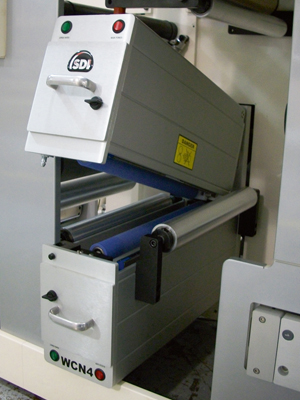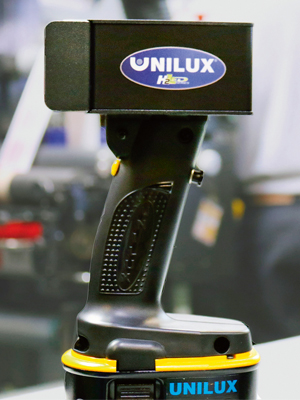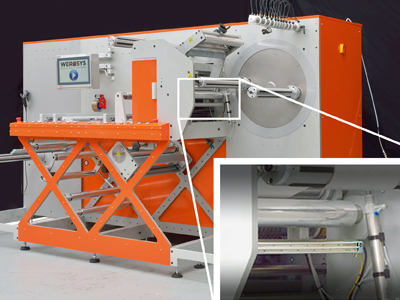Meech’s Hyperion 929IPS anti-static bars are being used by Werosys
The idea that web cleaning is a luxury, or something that is only required for certain jobs, is a thing of the past. A company that does not have its eye on machine downtime or wastage could soon be learning a very hard lesson. By Michal Lodej.
Many factors play an important role in cleaning a surface as contaminating particles can be hard to shift off the web. Adhesion and electrostatic forces can be controlled by a combination of high speed air movement and anti-static bars. Anti-static bars are usually positioned opposite one another prior to the cleaning action. This ensures a static free web entering the cleaning section reducing adhesion forces between surface and particles. A high pressure vacuum and a high pressure blowing air stream, which is directed against the movement of the web, creates a very efficient cleaning action.
Web speed is a factor, which needs to be considered when cleaning the web. The faster the web moves, the thicker the static layer of air moving along with the web, the boundary layer, grows. This boundary layer makes it difficult to pull particles from the web.
Web tension can also be an issue when cleaning a web. Insufficient web tension causes the web to be sucked into the vacuum system. Placing cleaning heads opposite to one another and applying exactly the same vacuum and air force tackles this issue.
Once the boundary layer of air and contaminates have been removed then any electrostatic forces need to be eliminated after the cleaning process too. Any movement of material and air will create static electricity. Static electricity on a web will attract particles from the surrounding area. Anti-static bars on both sides of the web after the cleaning section will neutralise the web.
Simco BV offers its customers the CleanION SE web cleaners saying it can remove particles down to 10 microns. The system uses a dust collector that also provides the air volume for the blowing section, so no additional compressed air is used.
The magic touch
Contact cleaning systems are still popular in the printing industry. Arcalian is the UK distributor for SDI, a US-based manufacturer of cleaning systems with a wide variety of contact (tacky roll) web cleaners.
This technology uses an engineered polymer roller on one or both sides of the web to pick up the loose, dry contamination such as dust, hair and lint. The polymer roller rotates in contact with a high coat-weight adhesive roller, to which the removed particles are transferred for later analysis and disposal. Once again anti-static bars prevent re-attraction of air and floor-borne particles to the cleaned web.

SDI’s WCN4 on a Nilpeter FB press showing optional extra switches for power and anti-static
Cleaning the web in this way removes particles smaller than 1 micron in size. A particle like this, if not completely removed from the web, will travel along the press, and if the press owner is lucky, will only interfere with the printing of one individual label.
However, the particle has the potential to cause a repeat fault, resulting in the press being stopped, the material being scrapped, and the laborious clean-down process of every print station to remove the offending particle. That one particle can be the difference between profit and loss.
Keep on rolling
Polymag Tek manufactures single-sided and double-sided web cleaners for narrow web applications. Its most basic model the 2RNWC-3IIA, a 3 inch OD contact cleaning roller (CCR) nips the substrate against an idler roller. The CCR removes the contaminants from the web, and then transfers them to an adhesive tape roller. Most models include pneumatic separation of the nip and the rollers when the press stops in order to prevent any conveyance issues.
The company’s clamshell model web cleaner 4RNWC-CD is targeted at customers that run their presses continuously for four hours or more without stopping. The clamshell has drawers for the adhesive tape that allow on the fly tape change. Although this feature is great for continuous operations, it adds to the cost of the machine and may be overkill for certain applications. The basic open frame four roll narrow web cleaner, 4RNWC-IIA, provides the same cleaning functionality but at a lower cost.
The company’s open frame narrow web cleaners can use the Extender self-oscillating adhesive tape roller. This roller moves back and forth across the face of the CCR, collecting particles for permanent removal. The Extender spreads contamination across a 1 inch area to avoid saturation of the adhesive tape along the line of travel of the web. With the Extender, the consumable adhesive tape lasts up to 12 times longer with respect to slit edge contamination helping to reduce consumable costs.
Additionally, the company offers oversized contact cleaning rollers. Instead of purchasing an entirely new roller, these CCRs can be touch ground or polished up to five times before a recover is needed, reducing the overall cost of ownership.
Its wide web cleaners come in multiple varieties. Machines are tailored to the customer’s line. It offers a standard nip design similar to the narrow web cleaners, NN-WC-DS, an S-Wrap design for thin films, a model that is convertible between a nip or an S-wrap, 2SNR-WC-DS, and even a step traversing tape unit to clean webs greater than 120 inches, 2SNR-WC-TTS. However, many customers run a variety of substrates on one line. These substrates do not always react the same to contact cleaning and so the company has built in programmable options for a convertible web cleaner.
Seeing is believing
An important part of keeping a web clean is inspection. Unilux, a manufacturer of inspection lighting, will be introducing two new LED strobes at drupa. According to the company, the new LED-3 and LED-9 stroboscopes provide an output twice as bright as earlier LED-based inspection lights and gives a more-defined coverage area. UV models enhance the ability to see special security codes or coatings that are only visible in the narrow UV light spectrum. LED technology significantly reduces maintenance over xenon-based inspection lights and eliminates inspection-system downtime caused by burned out lamps.

Unilux’s handheld strobe inspection unit will be on show at drupa
The new strobes can be configured for flood or spot lighting patterns and are available in handheld or fixed-mount configurations. They can reduce energy consumption by two-thirds and gain all the environmental and reduced-maintenance benefits that come with LED technology.
Handheld models feature a new ergonomic design to better suit the operator. New Lithium Ion batteries provide more power at a third of the weight and four times the longevity. Fixed-mount models feature remote operation and trigger inputs for instant synchronisation to movement. Multiple strobes can be connected across a machine to synchronise frequency in various locations or allow simultaneous use of UV and standard inspection lights.
‘The successful combination of compact design and bright illumination makes these new strobe s highly versatile,’ said Volker Schlevoigt, managing director, Unilux Europe GmbH. ‘They enable operators to optimise the inspection of print and coating quality, perform maintenance functions and do so much more. The brighter light – especially for UV units – in a smaller, lighter-weight design, lets operators perform these functions wherever it’s most efficient for their operations.’
Improving equipment efficiency
Werosys is the latest company to employ Meech’s static control solutions, with the installation of thirty Hyperion 929IPS anti-static bars in its production environment.
Based in Allerød, Denmark, Werosys specialises in the development of equipment for the label converting and finishing industry. Søren Pedersen, chief commercial officer, explained, ‘With our systems, you can run a series of jobs from one centralised PLC/HMI, whether it’s selecting varnish, importing the die cut shape to the laser, adjusting the automatic knife system or set up the rewinding. The result is reduced waste, reduced costs, an optimised production and enhanced capacity.’
Bjarke Gerdes-Nielsen, CTO and founder, commented, ‘The online monitoring capabilities of Meech’s technology fits perfectly with our full integration approach, where we are able to remote control and run diagnostics on machines from our site in Denmark via standard internet connection. This means that we can support our customers by planning preventative maintenance schedules to ensure that our machines do not have unscheduled break-downs and thereby offer the highest OEE (overall equipment efficiency) in the business.’
The Hyperion 929IPS is a compact pulsed DC ionising bar with Integrated Power Supply (IPS), with default settings that allow quick and easy installation and use on label production lines. A 24 V plug and play bar, it provides excellent static elimination for short to medium range applications (up to 500 mm). The adjustable performance and compact dimensions of the bar are also among the key benefits that appealed to Werosys.






